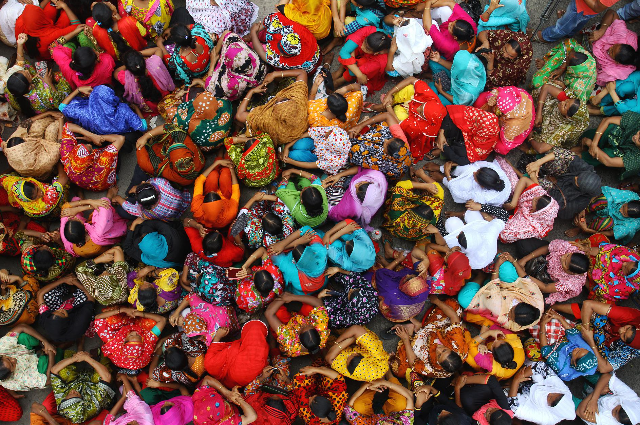
We have come a long way from where we began. Time has shifted, and so have the tectonic plates. What remains terrifyingly constant is, that people in power think that their needs and wants are more important than others. And history still shamelessly repeating itself. War is the worst evil that people have inflicted upon one another, at costs to themselves, since some hominid discovered the lethal efficacy of rocks.
But when there is nothing left besides mud, wire, and slaughter, there is art.
Front-line participants in war have carved art from the flotsam of battle — bullets, shell casings, and bones — often producing unsettling accounts of the calamity that had overwhelmed them. Tools of cruelty have been turned into testaments of compassion and civilians have created art out of the rubble.
Warriors expressed their inner lives on the walls of underground trenches, when the world, on the surface, was turning to hell.
War poems capture the darkest moments in human history, and also the most luminous. From ancient texts to modern free verse, war poetry explores a range of experiences,]and rebels against those who turn a blind eye.
There is a reason Wilfred Owen wrote that even Shakespeare seems ‘vapid’ after Siegfried Sassoon: ‘not of course because Sassoon is a greater artist, but because of the subjects’.
The earliest recorded war poetry is thought to be by Enheduanna, a priestess from Sumer, the ancient land that is now Iraq. In about 2300 BCE, she riled against war, writing:
“You are blood rushing down a mountain,Spirit of hate, greed, and anger,dominator of heaven and earth!”
Some World War I soldier poets romanticized their lives on the battlefield, writing poems so touching they were set to music. While others rejected romanticism. The early 20th century brought the Modernism movement when many writers broke from traditional forms. Poets experimented with plain-spoken language, gritty realism, and imagism.
British poet Wilfred Owen, who died in battle at age 25, did not spare the shocking details. In his poem, “Dulce et Decorum Est”, soldiers trudge through sludge after a gas attack. A body is flung onto a cart, “white eyes writhing in his face”.
“My subject is War, and the pity of War,” Owen wrote in the preface to his collection.
Prisoners in Nazi concentration camps documented their experiences on scraps that were later found and published in journals and anthologies.
In “First They Came”, Pastor Martin Niemöller said —“Then they came for the JewsAnd I did not speak outBecause I was not a JewThen they came for meAnd there was no one leftTo speak out for me.”
Brian Turner’s poem “The Hurt Locker” chronicled chilling lessons from the horrifying military action in Iraq:
“Nothing but hurt left here.
Nothing but bullets and pain...
Believe it when you see it.
Believe it when a twelve-year-old
rolls a grenade into the room.”
Landay's began among the nomads and farmers of Afghanistan. They were shared around a fire, sung after a day in the fields or at a wedding. More than three decades of wars have diluted a culture, as well as displaced millions of people who can’t return safely to their villages. But Landay's are still sung, and singing is linked to licentiousness in the Afghan consciousness. Much of an Afghan woman’s life involves a cloak-and-dagger dance around honor — a gap between who she seems to be and who she is.
“I’m tired of praising exotic flowers.I miss Sangin’s gardens; they were poor but ours.Separation brought this kind of grief:it made itself a mullah and me the village thief.”— hums Basbibi.
During the 19th century Ottoman and Russian domination, Armenians experienced a cultural revival and increasing nationalistic leanings, stirred by their intellectual community and increased literacy. In 1915, on the eve of the First World War, Turkish nationalist reformers responded by rounding up 250 writers and intellectuals in the Western community and began what is now known as the Armenian Genocide.
Amidst the pull of multiple diasporic identities, an Armenian student writes —
“In what language do I remember things in?In what language do I tell jokes in?In what language do I think in?”“we stopped digging deep long agoin this uncertain field of ours-yoursbecause all kinds of junk can turn up:human bones, horses’ heads, unexploded mines”
Halyna Kruk’s poems of war are gut-wrenching. She picks apart Ukrainian soil, unearthing the detritus of history. Ukraine’s fertile earth, known as “chernozem” or “black soil”, has been cultivated and coveted. The land that has been sown with crops has also been sown with the casualties of history. As Timothy Snyder puts it in his 2012 Bloodlands, “Even human ash fertilizes.”
The past is full of lessons for those who want to learn, and the lessons are neither hard nor bitter. We get what we seek from our past. If we are looking for hope, it is full of it. If we are pessimistic about human history, then the past offers an abundance of excuses for that, too. It is all up to us to wisely choose lessons that suit us, and learn from them. Use the wisdom to sail through the present, while building a rich heritage for future generations, for whom we will soon be boring pages of history.
“I don’t know who sold our homelandBut I saw who paid the price.”— Mahmoud Darwish
The victors and the defeated, the landscapes in which they moved, and imagined pasts, presents, and futures are refracted through the creative energies of art. The dead life on in the hand of the artist, and the eye of the witness.
Loss is there for all to see. All we need to do is look closely for hope, rather than looking away.
